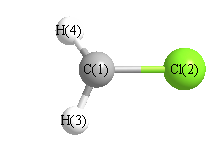Jump to
S1C2
Energy calculated at B2PLYP=FULLultrafine/STO-3G
| | hartrees |
|---|
| Energy at 0K | -493.705989 |
| Energy at 298.15K | |
| HF Energy | -493.689087 |
| Nuclear repulsion energy | 43.660943 |
The energy at 298.15K was derived from the energy at 0K
and an integrated heat capacity that used the calculated vibrational frequencies.
Vibrational Frequencies calculated at B2PLYP=FULLultrafine/STO-3G
| Mode Number |
Symmetry |
Frequency
(cm-1) |
Scaled Frequency
(cm-1) |
IR Intensities
(km mol-1) |
Raman Act
(Å4/u) |
Dep P |
Dep U |
|---|
| 1 |
A' |
3401 |
3401 |
1.78 |
38.59 |
0.14 |
0.25 |
| 2 |
A' |
1531 |
1531 |
21.04 |
8.31 |
0.75 |
0.86 |
| 3 |
A' |
904 |
904 |
32.81 |
8.64 |
0.34 |
0.50 |
| 4 |
A' |
671 |
671 |
16.23 |
1.38 |
0.22 |
0.36 |
| 5 |
A" |
3599 |
3599 |
0.39 |
23.72 |
0.75 |
0.86 |
| 6 |
A" |
1059 |
1059 |
2.71 |
6.05 |
0.75 |
0.86 |
Unscaled Zero Point Vibrational Energy (zpe) 5582.7 cm
-1
Scaled (by 1) Zero Point Vibrational Energy (zpe) 5582.7 cm
-1
See section
III.C.1 List or set vibrational scaling factors
to change the scale factors used here.
See section
III.C.2
Calculate a vibrational scaling factor for a given set of molecules
to determine the least squares best scaling factor.
Geometric Data calculated at B2PLYP=FULLultrafine/STO-3G
Point Group is Cs
Cartesians (Å)
| Atom |
x (Å) |
y (Å) |
z (Å) |
|---|
| C1 |
-0.024 |
1.175 |
0.000 |
| Cl2 |
-0.024 |
-0.607 |
0.000 |
| H3 |
0.272 |
1.638 |
0.952 |
| H4 |
0.272 |
1.638 |
-0.952 |
Atom - Atom Distances (Å)
| |
C1 |
Cl2 |
H3 |
H4 |
| C1 | | 1.7825 | 1.0988 | 1.0988 |
Cl2 | 1.7825 | | 2.4569 | 2.4569 | H3 | 1.0988 | 2.4569 | | 1.9031 | H4 | 1.0988 | 2.4569 | 1.9031 | |
 More geometry information
More geometry information
Calculated Bond Angles
| atom1 |
atom2 |
atom3 |
angle |
|
atom1 |
atom2 |
atom3 |
angle |
| Br2 |
C1 |
H3 |
114.940 |
|
Br2 |
C1 |
H4 |
114.940 |
| H3 |
C1 |
H4 |
119.991 |
|
Electronic energy levels
Charges, Dipole, Quadrupole and Polarizability
Jump to
S1C1
Energy calculated at B2PLYP=FULLultrafine/STO-3G
| | hartrees |
|---|
| Energy at 0K | -493.704769 |
| Energy at 298.15K | |
| HF Energy | -493.688036 |
| Nuclear repulsion energy | 43.778354 |
The energy at 298.15K was derived from the energy at 0K
and an integrated heat capacity that used the calculated vibrational frequencies.
Vibrational Frequencies calculated at B2PLYP=FULLultrafine/STO-3G
| Mode Number |
Symmetry |
Frequency
(cm-1) |
Scaled Frequency
(cm-1) |
IR Intensities
(km mol-1) |
Raman Act
(Å4/u) |
Dep P |
Dep U |
|---|
| 1 |
A1 |
3433 |
3433 |
2.46 |
36.40 |
0.14 |
0.24 |
| 2 |
A1 |
1513 |
1513 |
28.14 |
|
|
|
| 3 |
A1 |
914 |
914 |
29.28 |
|
|
|
| 4 |
B1 |
516i |
516i |
43.39 |
|
|
|
| 5 |
B2 |
3644 |
3644 |
2.49 |
|
|
|
| 6 |
B2 |
1023 |
1023 |
2.58 |
|
|
|
Unscaled Zero Point Vibrational Energy (zpe) 5005.5 cm
-1
Scaled (by 1) Zero Point Vibrational Energy (zpe) 5005.5 cm
-1
See section
III.C.1 List or set vibrational scaling factors
to change the scale factors used here.
See section
III.C.2
Calculate a vibrational scaling factor for a given set of molecules
to determine the least squares best scaling factor.
Geometric Data calculated at B2PLYP=FULLultrafine/STO-3G
Point Group is C2v
Cartesians (Å)
| Atom |
x (Å) |
y (Å) |
z (Å) |
|---|
| C1 |
0.000 |
0.000 |
-1.165 |
| Cl2 |
0.000 |
0.000 |
0.608 |
| H3 |
0.000 |
0.968 |
-1.675 |
| H4 |
0.000 |
-0.968 |
-1.675 |
Atom - Atom Distances (Å)
| |
C1 |
Cl2 |
H3 |
H4 |
| C1 | | 1.7729 | 1.0941 | 1.0941 |
Cl2 | 1.7729 | | 2.4798 | 2.4798 | H3 | 1.0941 | 2.4798 | | 1.9355 | H4 | 1.0941 | 2.4798 | 1.9355 | |
 More geometry information
More geometry information
Calculated Bond Angles
| atom1 |
atom2 |
atom3 |
angle |
|
atom1 |
atom2 |
atom3 |
angle |
| Br2 |
C1 |
H3 |
117.803 |
|
Br2 |
C1 |
H4 |
117.803 |
| H3 |
C1 |
H4 |
124.393 |
|
Electronic energy levels
Charges, Dipole, Quadrupole and Polarizability
